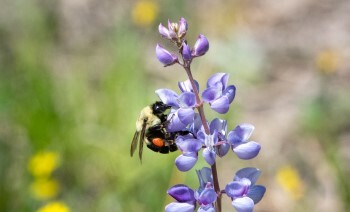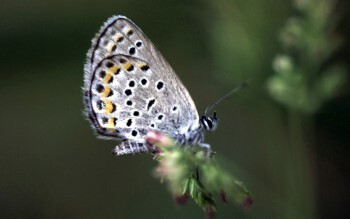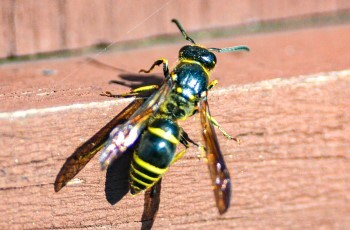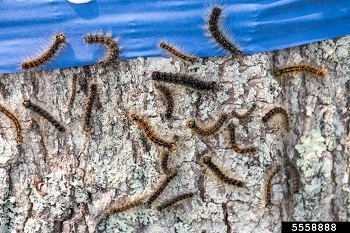|
Here are a few of this week's stories from the Michigan Department of Natural Resources:
See other news releases, Showcasing the DNR stories, photos and other resources at Michigan.gov/DNRPressRoom.
PHOTO FOLDER: Larger, higher-res versions of some of the images used below, and others, are available in this folder.
Questions about this newsletter content? Email DNR-Public-Info@Michigan.gov.

Summer officially rolls in this week, and soon the buzz of insect wings will fill the air. Many of those insects will benefit the flowering plants around them, helping them grow and mature through the process of pollination.
Pollinators serve a critical function in our ecosystems, often acting as keystone species, which means they support a large variety of other species through their natural function. According to Pollinators.org, these essential creatures are the “unsung heroes” behind the food we enjoy and the natural beauty that surrounds us.
Many pollinators are generalists, visiting all manner of plants for nectar and pollen, while some, like monarch butterflies, specialize in one plant (milkweed). But there’s more to pollinators than first meets the eye, and more species take part in this natural process than you might think. During National Pollinator Week (also honored here in Michigan), let’s look at a few.
Bees and butterflies
Bumblebees are some of the best pollinators in nature, their soft, fuzzy bodies perfect for “buzz pollination.” They're often the first bees active after winter, and the last ones buzzing around in fall. Unfortunately, many species of bumblebee are federally endangered.
Mason bees are excellent pollinators, giving a boost to fruit trees, berries and flowers. This solitary species nests in hollow stems, with the female creating as many egg chambers as she can before the end of her life cycle. In the process, she visits an enormous quantity of flowers, bringing back pollen and nectar for her brood to feast on when they emerge from their cells. Gentle and nonaggressive, these bees rarely sting.
Monarch butterflies are one of the most recognizable butterfly species, making their summer home here in Michigan. Monarchs rely solely on varieties of milkweed to host their young and provide much-needed food sources. Due to a loss of habitat, the eastern North American monarch population has declined by 90% in the last two decades according to the Center for Biological Diversity, prompting an increase in conservation efforts. You can log your monarch observations with Journey North and learn how to make a monarch waystation to support population recovery.
|

Much like the monarch relies on milkweed, the tiny (and federally endangered) Karner blue butterfly hosts only on wild or sundial lupine (Lupinus perennis). Karner butterflies and lupines are found only in oak barrens, pine barrens, dry sand prairies and other open areas with sandy soil. These habitats are some of the rarest natural systems in the world, having slowly declined and degraded since European settlement.
Michtell’s satyr is one of the world’s rarest butterflies and can be found only in Michigan and Indiana. The biggest threat to their continued survival is habitat loss and modification. Satyrs need a special kind of wetland habitat found in prairie fens, many of which have been altered or drained for agriculture or development, unintentionally paving the way for invasive species in those areas.
Birds
The ruby-throated hummingbird is the only hummingbird found in the eastern United States. Hummingbirds are especially good pollinators of long, tubular flowers; their slim, lengthy tongues reach the tasty nectar and, in the process, coat their faces in pollen, which they bring to the next flower.
Flies and wasps
Humans might find them annoying, but flies and wasps serve a vital ecological function. Besides being food for other species, they are also important pollinators.
Two-winged insects like flies, bee mimics and yes, even mosquitoes, are pollinators. While not as effective as other insects, they pollinate plants others can’t. Some plant species have evolved alongside flies, and instead of producing nectar they put out a scent like rotting meat. As flies are natural decomposers, they find the scent of flowers like red trillium, jack-in-the-pulpit, skunk cabbage and more irresistible.
|

Wasps, too, are vital pollinators. In addition to acting as decomposers and prey species, wasps have miniscule hairs on their bodies, carrying pollen from plant to plant as they search for nectar. Due to their high energy needs, wasps visit a large volume of pollen-producing plants, ensuring hearty pollination.
While any loud, buzzing insect can be frightening, most won’t sting without reason, so avoid nests and don’t swat at them if you can help it.
Wind
One of the biggest pollinators is the force of nature itself. Species that rely solely on wind pollination are usually small and inconspicuous, don’t produce nectar and don’t release a scent to attract animal pollinators. Their pollen grains are released into the air, where they’re carried to other plants by the wind.
Wind can also scatter seeds, helping beneficial plants like milkweed, but also can disperse harmful pesticides and air pollutants, which can seriously harm insect populations.
Pollinators come in a variety of shapes, sizes and species, and many are facing challenges. Learning more about them and taking steps to help address those challenges are key to aiding these valuable species.
|

One of the best ways to help pollinators now is to garden for the future; planting native species – especially perennials, which come back year after year – creates habitat for all sorts of beneficial creatures. Wherever you’re planning to install a pollinator garden, make sure you know what species will best thrive in the area you’ve chosen. Soil type and pH (acidity level), light and water are key elements to note before you break ground.
Be intentional about what you plant and have a plan.
Trees for bees
Native flowering trees like basswood, crabapple, catalpa and more are great nectar and pollen sources. These trees also attract other wildlife.
Learn how to care for these beneficial and beautiful trees and how to add them to your yard or neighborhood.
Plant native
There are many resources online to help you design and install a pollinator garden, and familiarizing yourself with plants best suited for your local landscape can be immensely helpful.
Unfortunately, many nurseries, greenhouses and landscape companies still sell plants that are known to cause harm to local ecology. These ornamental plants are attractive but can grow beyond garden boundaries and cause havoc on the surrounding habitat. Many times, they have misleading names that can cause confusion.
|

It’s easy to mix up species with similar names; plants like butterfly bush (Buddleja davidii) are often touted as great for pollinators but in reality are invasive. Butterfly weed (Asclepias tuberosa), on the other hand, is a native variety of milkweed and much better suited for pollinator gardens. If you live in an area that can grow Karner blue habitat, make sure to plant wild lupine and avoid the big leaf variety (Lupinus polyphyllus), which can’t support Karner blue caterpillars.
When looking for native species suited for your area, your local conservation district is a great place to start. Check out programs like Go Beyond Beauty, too, which is dedicated to promoting native species while phasing out nonnative ornamentals.
If your goal is to create a pollinator paradise, make sure you know what you’re planting!
Become a community scientist
It can be hard to study bugs. Small, fleet critters are difficult to track, especially if they’re solitary. Many species are lacking significant data, meaning we don’t really know much about them. That’s where you come in.
Databases like BeeSpotter and Bumble Bee Watch help track bee sightings and offer resources for identifying species. Other community science databases like iNaturalist can help identify and log sightings of all manner of species, especially when paired with the Seek smartphone application.
Whether you live in the country, the city or anywhere between, here are a few things you can do right now to help pollinators:
- Get involved in your local conservation district and volunteer for community science opportunities in your area.
- Learn more about Michigan’s native species and how to identify them.
- Keep a pollinator journal.
- Download Seek and iNaturalist onto your smartphone.
- Leave your garden alone in the fall and spring – many insects overwinter in plant matter. Leave bare patches of earth, and don’t rake leaves or trim back pithy-stemmed plants with long, hollow stalks that dry out over fall and winter.
|

Now that you have a starting point for Michigan’s beneficial species, it’s a good idea to familiarize yourself with what to watch out for, too.
Summer is the busy season for most creatures, including invasive species like spongy moth, box tree moth and Japanese beetle, to name just a few. Many of these species are established in Michigan, meaning they’re here to stay, but if you know what to look out for, you can help contain their spread and mitigate further environmental damage. While these bugs are just following their natural instincts, their presence can affect the delicate balance of ecosystems, making it harder for native species to thrive.
Spongy moth caterpillars is infesting some areas of the state. This species is known for its defoliation, often leaving trees vulnerable to diseases and other pests, which may lead to tree mortality.
Box tree moth caterpillars feed mostly on boxwood, hence their name, and heavy infestations can defoliate host plants. Once the leaves are gone, larvae consume the bark, leading to girdling – injuring the bush's limbs in an exterior ring and interrupting the flow of nutrients – and plant death. The Michigan Department of Agriculture and Rural Development has issued an interior quarantine preventing movement of boxwood plants, plant parts and nursery stock from several counties in Michigan to slow the spread of this invasive pest.
Gardeners well know the sight of Japanese beetles, another prolific defoliator. Adults emerge from their grub stage in June and July, feeding on plants throughout the rest of summer. They can skeletonize leaves and flowers of ornamental plants and trees and can damage crops.
While you're on the lookout for these species and more, make sure not to move firewood, which can transport invasive species and diseases into new areas. If you’re planning to have a fire, buy your wood from sources local to where you plan to burn.
Keep up to date with Michigan invasive species, including emerging or potentially threatening species on Michigan's watch list. If you see an invasive species on the list, use the Midwest Invasive Species Information Network online reporting tool or download the MISIN smartphone app and report from your phone.
Want a more detailed look into invasive species? Check out this recent Showcasing the DNR story and sign up for a NotMISpecies webinar.
Find more information on invasive species in Michigan and management practices at Michigan.gov/Invasives.
|

Today through Sunday, much of the state will experience temperatures in the 90s, with heat index values near and above 100 degrees. When humidity is added to the mix, it can make temperatures feel even hotter, and heat can worsen air quality. Whether you want to work in the garden or just go for a walk, always take proper precautions.
Excessive heat disrupts our bodies from cooling properly, and access to water and cooling centers is critical – especially for the elderly and people with medical conditions.
Stay safe with these tips:
- Limit outdoor activities to when it is coolest in the morning and evening.
- Spend time indoors in air conditioning.
- Make sure your air conditioner filters are clean and the unit is working properly.
- Wear lightweight, light-colored and loose-fitting clothing.
- Wear sunscreen, as sunburn affects a body’s ability to cool down.
- Check on neighbors and relatives to see if they need assistance.
- Never leave children or pets unattended in cars, even with the windows cracked.
Heatstroke occurs when the body is unable to regulate its temperature and can result in death if not treated promptly. If you suspect someone has heatstroke, call 911 for immediate medical help and try to cool the person down by moving to a cooler environment and using cool cloths or a cool bath.
Make sure, too, to check the Air Quality Index, which can be found on the AirNow website. This map offers a color-coded way to see the levels of some types of air pollution in your area. Higher AQI values indicate a higher concentration of pollutants in the air and a need for people to take steps to protect their health.
For more information and guidance, visit Michigan.gov/ClimateandHealth and the Centers for Disease Control and Prevention website.
|

See more pictures by Michigan state parks photo ambassadors at Instagram.com/MiStateParks. For more on the program, call Stephanie Yancer at 989-274-6182. (This photo is by Marybeth Kiczenski, for the Michigan DNR, at Dodge #4 State Park in Oakland County.)
|